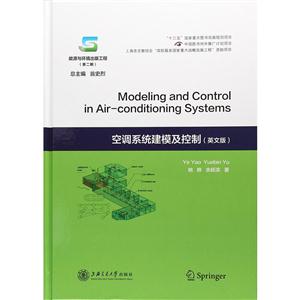-
>
湖南省志(1978-2002)?铁路志
-
>
公路车宝典(ZINN的公路车维修与保养秘籍)
-
>
晶体管电路设计(下)
-
>
基于个性化设计策略的智能交通系统关键技术
-
>
德国克虏伯与晚清火:贸易与仿制模式下的技术转移
-
>
花样百出:贵州少数民族图案填色
-
>
识木:全球220种木材图鉴
空调系统建模及控制-(英文版) 版权信息
- ISBN:9787313180803
- 条形码:9787313180803 ; 978-7-313-18080-3
- 装帧:一般胶版纸
- 册数:暂无
- 重量:暂无
- 所属分类:>>
空调系统建模及控制-(英文版) 本书特色
《空调系统建模及控制(英文版)》主要内容包括:集中空调系统状态空间建模原理、过程及图论描述方法,空调系统中传感器虚拟标定技术及虚拟传感器模型,双环路模型预测控制模型,空调负荷组合预测模型,空调系统能量评价分析模型,空气处理单元机群(AHUs)协同控制模型,以及基于负荷预测的空调系统全局优化节能控制模型。
《空调系统建模及控制(英文版)》内容新颖且信息量大,注重于计算机仿真与实验相结合以及理论分析和应用实例相结合,是一本建筑环境与设备工程和自动控制学科深度交叉、系统反映新成果的难得的参考书。
《空调系统建模及控制(英文版)》可供从事建筑环境与设备工程、热能工程、制冷与低温工程、自动控制工程以及相关专业的本科生和研究生参考使用,也可作为从事相关领域研究的科研人员的参考用书。
空调系统建模及控制-(英文版) 内容简介
本书是“能源与环境出版工程”之一。本书系统论述了集中空调系统关键部件状态空间模型的建立过程和方法,并通过实验对各部件状态空间模型进行了验证,引入图论和结构矩阵理论对部件状态空间模型。本书内容全面、新颖,覆盖了建筑环境及设备工程领域近期新建模方面的研究成果。该书的主要内容取材于作者的亲身研究经历和工作经验,具有较高的原创性。
空调系统建模及控制-(英文版) 目录
1.1 Background
1.2 Modeling Approaches in HVAC Field
1.2.1 Physics-Based Modeling Approach
1.2.2 Data-Driven Modeling Approach
1.2.3 Hybrid Modeling Approach
1.3 Proposed Methods
1.3.1 State-Space Modeling
1.3.2 Graph-Theory Modeling
1.3.3 Combined Forecasting Modeling
1.3.4 Decomposition-Coordination Algorithm for Global Optimization Model
1.3.5 Virtual Calibration for HVAC Sensors
1.3.6 Model-Based Predictive Control (MPC)
1.4 Organization of This Book
References
2 Component Modeling with State-Space Method
2.1 Basic Knowledge about State-Space Modeling Method
2.2 Modeling for HVAC Components
2.2.1 Water-to-Air Heat Exchanger
2.2.2 Chiller
2.2.3 Cooling Tower
2.2.4 Duct (Pipe) and Fan (Pump)
2.2.5 Air-Conditioned Room Modeling
2.3 Modeling for HVAC System
2.3.1 Component Model Connection
2.3.2 State-Space Representation for HVAC System
2.3.3 Case Study
References
3 Dynamic Simulations with State-Space Models
3.1 On Water-to-Air Surface Heat Exchanger
3.1.1 Subjected to Different Perturbations
3.1.2 For Different Initial Conditions
3.2 On Chiller
3.2.1 Subjected to Different Perturbations
3.2.2 For Different Initial Conditions
3.3 On Cooling Tower
3.3.1 Subjected to Different Perturbations
3.3.2 For Different Initial Conditions
3.4 On Duct and Pipe
3.4.1 On Straight-Through Duct
3.4.2 On Straight-Through Pipe
3.5 On Air-Conditioned Room
3.5.1 Basic Conditions
3.5.2 Subjected to Different Perturbations
4 Graph-Theory Modeling and Structure-Matrix Analysis
4.1 Graph-Theory Modeling for HVAC Component State-Space Models
4.1.1 Fundamental Rules
4.1.2 Case Study
4.2 Graph-Theory Modeling for HVAC System
4.2.1 Basic Method
4.2.2 Case Study
4.3 Structure-Matrix Analysis Approach
4.3.1 Model Structural Matrix
4.3.2 Reachability Analysis of Model Input-Output
4.3.3 Controllability/Observability Analysis of Model
4.3.4 Case Study
References
5 Virtual Measurement Modeling
5.1 Virtual Calibration
5.1.1 Conventional Calibration
5.1.2 Methodology of Virtual In Situ Calibration
5.1.3 Case Study
5.2 Virtual Sensing
5.2.1 Development Methodology for Virtual Sensing
5.2.2 Case Study
5.2.3 Model Development
References
6 Control Design Based on State-Space Model
6.1 Model-Based Predictive Control (MPC)
6.1.1 Introduction of MPC
6.1.2 MPC in Broad Definition
6.2 Applications of MPC in HVAC Field
6.2.1 Control of a Hybrid Ventilation Unit
6.2.2 Control of Space Thermal Conditioning
6.3 State-Space Feedback Control System Design
6.3.1 Basic Principle
6.3.2 Control System Design for Water-to-Air Heat Exchanger
6.3.3 MATLAB Simulation of the Control System
6.3.4 Control System Design for Refrigeration System
References
7 Combined Forecasting Models for Air-Conditioning
Load Prediction
7.1 Typical Methods
7.1.1 MLR Modeling
7.1.2 ARIMA Modeling
7.1.3 GM Modeling
7.1.4 ANN Modeling
7.2 Combined Forecasting Model Based on Analytic Hierarchy Process (AHP)
7.2.1 Principles of the Combined Forecasting Method
7.2.2 Determining Weights by Analytic Hierarchy Process (AHP)
7.2.3 Combined Forecasting Model for Hourly Cooling Load Prediction Using AHP
7.3 Forecasting Model Based on Neural Network and Combined Residual Error Correction
7.3.1 Model Development
7.3.2 Case Study
References
8 Energy Analysis Model for HVAC System
8.1 Energy Models for HVAC Components
8.1.1 Chiller
8.1.2 Boiler
8.1.3 Pump and Fan
8.1.4 Cooling Tower
8.1.5 Water-to-Air Heat Exchanger
8.2 Energy-Saving Analysis on VAV Air-Conditioning System
8.2.1 Evaluation Program for Energy Saving of VAV System
8.2.2 Case Study
8.3 Energy Analysis on VAV Air-Conditioning System with Different Air-Side Economizers
8.3.1 Scheme for Air Economizer Cycle
8.3.2 Case Study
References
9 Optimal Control of HVAC System Aiming at Energy Conservation
9.1 Air-Side Synergic Control
9.1.1 Background and Basic Idea
9.1.2 Mathematic Deduction of Synergic Control Model
9.1.3 Control Logic Details
9.1.4 Case Study
9.2 Global Optimization Control
9.2.1 Model Development
9.2.2 Decomposition-Coordination Algorithm for Model Solution
9.2.3 Case Study
Appendix
References
10 Modeling and Control Strategies for VAV Systems
10.1 Background and Research Status
10.2 Modular Modeling with Simulink Tool
10.3 Model Library for Components of VAV System
10.3.1 VAV Terminal Unit
10.3.2 Variable Speed Fan
10.3.3 Air Ducts
10.3.4 Other Local Resistance Components
10.3.5 Application of Component Model Library: Case Study
10.4 Control Strategies for VAV System
10.4.1 Constant Static Pressure Method
10.4.2 Total Air Volume Method
10.4.3 Variable Static Pressure Method Based on Trim-and-Respond Logic
10.5 Control Sequences for VAV System with Different Terminal Units
10.5.1 For Cooling-Only Terminal Unit
10.5.2 For Reheat Terminal Unit
10.5.3 For Series Fan-Powered Terminal Unit
10.6 Test Script for VAV Control Study
10.6.1 Preparation
10.6.2 General Inspection of Air-Handling and Distribution System
10.6.3 Trend Data Review
References
- >
伯纳黛特,你要去哪(2021新版)
伯纳黛特,你要去哪(2021新版)
¥15.9¥49.8 - >
我从未如此眷恋人间
我从未如此眷恋人间
¥32.4¥49.8 - >
推拿
推拿
¥12.2¥32.0 - >
经典常谈
经典常谈
¥12.7¥39.8 - >
中国人在乌苏里边疆区:历史与人类学概述
中国人在乌苏里边疆区:历史与人类学概述
¥35.5¥48.0 - >
二体千字文
二体千字文
¥14.0¥40.0 - >
名家带你读鲁迅:故事新编
名家带你读鲁迅:故事新编
¥13.0¥26.0 - >
新文学天穹两巨星--鲁迅与胡适/红烛学术丛书(红烛学术丛书)
新文学天穹两巨星--鲁迅与胡适/红烛学术丛书(红烛学术丛书)
¥9.9¥23.0
-
机构运动微分几何学分析与综合
¥38.8¥88 -
4.23文创礼盒A款--“作家言我精神状态”
¥42.3¥206 -
4.23文创礼盒B款--“作家言我精神状态”
¥42.3¥206 -
一句顶一万句 (印签版)
¥40.4¥68 -
百年书评史散论
¥14.9¥38 -
1980年代:小说六记
¥52.8¥69





















